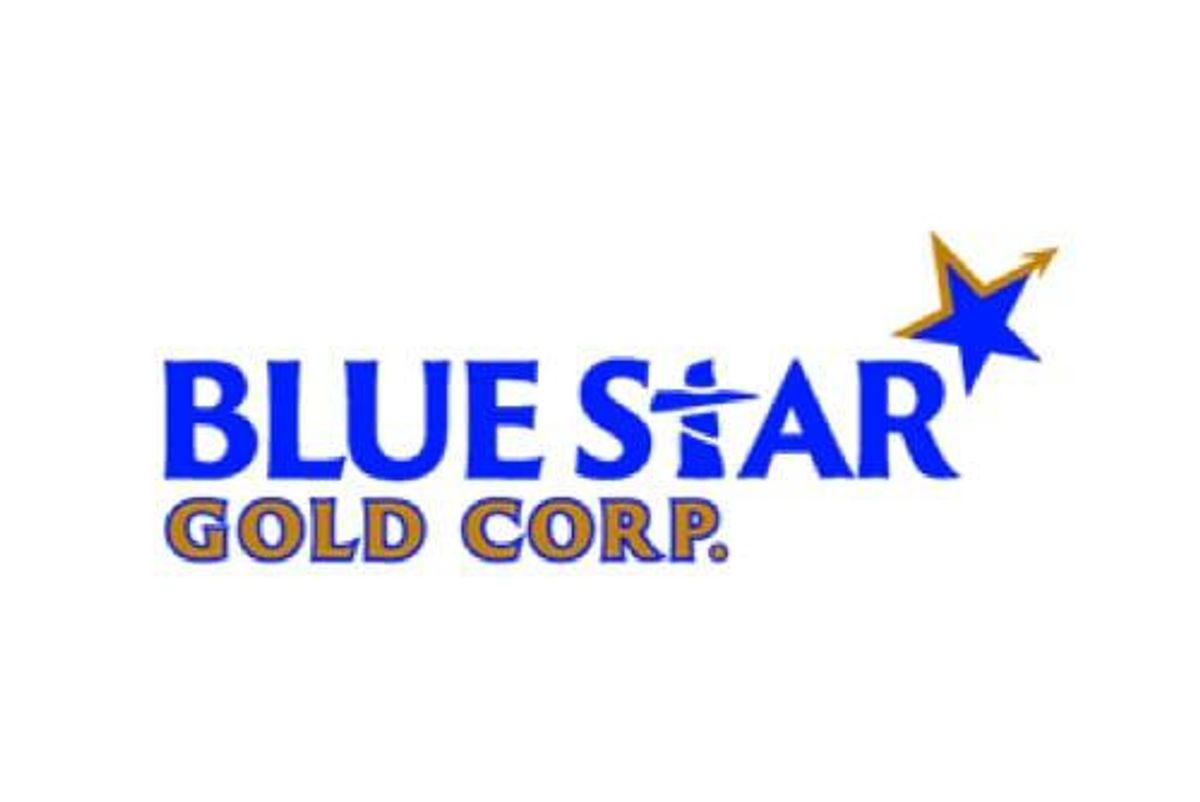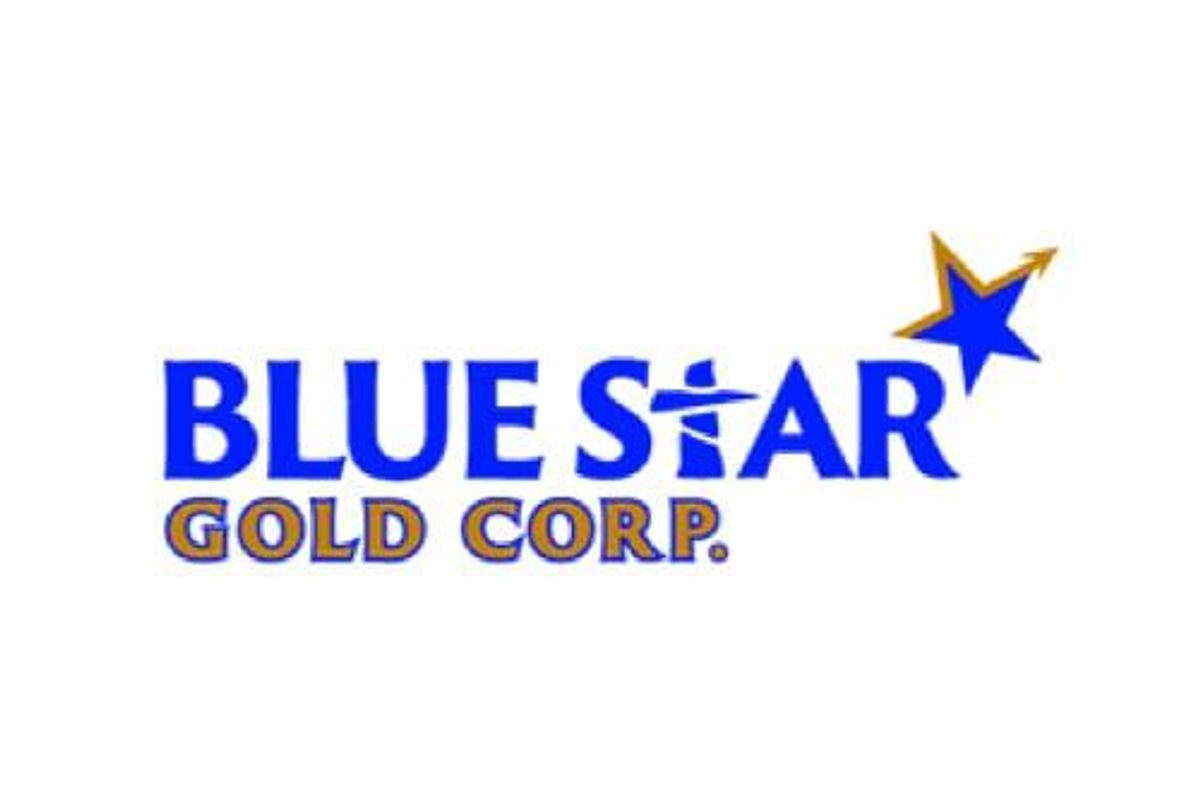
Blue Star Gold Corp. (TSXV: BAU) (FSE: 5WP0) (OTCQB: BAUFF) ("Blue Star" or the "Company") is pleased to provide all final outstanding results including surface samples, re-sampled historical drill core and drilling results from the 2021 exploration program at its Ulu Project located in the High Lake Greenstone Belt, Nunavut.
Highlights of the 2021 Drill Program:
- Shallow Flood Zone hole 21BSG025 returns interval of 4.65 m of 5.80 grams per tonne (g/t) gold
- Additional sampling of historic hole 04UL-02 revises interval to 26.35 m of 3.36 g/t gold by sampling between previously modelled higher grade and lower grade mineralized lenses
- North Fold Nose (NFN) east limb hole 21BSG017 returns 2.05 m of 10.10 g/t gold (including 1.13 m of 11.35 g/t gold)
- Gnu Zone hole 21BSG020, a follow up hole to 21BSG007, returns 5.34 m of 3.72 g/t gold (including 0.83 m of 12.95 g/t gold)
- Regional sampling highlights include a 12.60 g/t gold grab sample from Roma Fold
- Previously reported highlights include (see news releases dated Sept. 1, Sept. 22, and Oct. 28, 2021):
- 21BSG007 intersected 8.15 m of 20.80 g/t gold in a new vein system in the Gnu area
- 21BSG001 returned 4.91 m of 19.10 g/t gold & 7.00 m of 6.90 g/t gold in Flood Zone lenses
- 21BSG002 returned 2.64 m of 13.00 g/t gold in the Flood Zone; expanded high grade core
- 21BSG006 returned 2.18 m of 11.06 g/t gold following up on drill hole BS2020ULU-007 which returned 2.00 m of 52.7 g/t gold from the Gnu zone
CEO Grant Ewing commented, "Blue Star has numerous very prospective target zones throughout its extensive landholdings that have seen only limited modern-day exploration as most of the focus historically has been on delineating our high-grade Flood Zone gold deposit. The addition of the Roma project in 2021 and the discovery of a new vein system at the Gnu Zone, which represents a different style of gold mineralization from that of the Flood Zone deposit, adds to our potential for further new discoveries and resource growth. The 2021 exploration program successfully delivered several gold intersections in different zones on our projects and upgraded and expanded Blue Star's extensive target pipeline."
Mr. Ewing continued: "With the final release of the 2021 program assay data, we now have a better understanding of the geochemical and structural controls on our projects. We continue to unravel the structural architecture and develop improved targeting techniques, and the team is excited to test these concepts in our upcoming 2022 exploration program."
2021 Exploration Program
Blue Star initiated its 2021 exploration program in June with a geophysics campaign, followed by a drill campaign and a surface exploration program and successfully completed all phases of the program in September. The exploration campaign evaluated several high priority targets near the known high-grade Flood Zone gold deposit on the Ulu Project. Objectives of the 2021 program included better understanding the controls of higher-grade zones within the hosting structures, evaluating additional structures on and adjacent to the Ulu fold hinge, and defining additional targets for potential near-term discovery.
Summary
The final results from the 2021 exploration program are summarized below. Drill results are from the Flood Zone, the NFN target, the Central Zone, and the Gnu area with a single aborted hole reported from the East Limb target. Also included are additional results from core sampling completed through alteration zones in historical core that were not sampled previously, and surface samples from the regional evaluation work.
The final drill hole testing the Flood Zone, 21BSG025, intersected the targeted near surface mineralization which returned 4.65 m of 5.80 g/t gold from 25 m. Additional samples were collected from historical drill core in the Flood Zone, including holes 04UL-02, 04UL-09, 92VD154, 92VD155, and 92VD165. The sampling in 04UL-02 was successful in expanding a mineralized interval by 6.15 m. The previously unsampled interval was between high-grade and low-grade lenses, and the sampling program resulted in a significant improvement in the overall interval. The revised continuous mineralized interval expanded to 26.35 m at 3.36 g/t gold including 7.45 m of 6.90 g/t gold. Sampling of 92VD165 expanded shoulder samples from a historic 12 g/t gold value; the previous interval was 5.8 m at 2.83 g/t gold. The revised interval is 8.80 m of 2.43 g/t gold including 1.55 m of 8.05 g/t gold.
Two drill holes were completed at the NFN Target to better model a section through the geology and mineralization. It appears the shallow dipping west limb of the folded target zone is thin and carries highly variable but generally lower gold grades than the more steeply dipping east limb and the inferred hinge zone. Hole 21BSG017 returned 2.05 m of 10.10 g/t gold.
Follow up drill holes to significant results in the Gnu Target Area included one hole to confirm the previously reported intercept in 21BSG007 (8.15 m of 20.8 g/t reported on Sept. 01, 2021). This drill hole, 21BSG020, returned an interval of multiphase veining with an assay result of 5.34 m of 3.72 g/t gold (approximate true with of 5 m) which includes an interval of polymetallic vein (1.60 m of 7.33 g/t gold) and an interval of quartz vein (1.94 m of 4.12 g/t gold). Two additional short holes evaluated a surface exposure of a multiphase, metre-scale quartz vein interpreted to be the possible extension of the vein in drillholes 21BSG007 and 21BSG020. Only one hole intersected the inferred structure with a narrow intercept of 0.95 m at 1.53 g/t gold. Hole 21BSG022 stepped eastward along the acicular target zone and returned a wide alteration zone of 5.18 m of 0.59 g/t gold containing an interval of interest of 1.00 m of 1.32 m g/t gold.
A single drill hole evaluated the inferred intersection of the Central and Axis zones; 21BSG018 returned no values of interest. One hole was set to evaluate the first target in the East Limb Zone but was aborted; drill hole 21BSG019 returned 0.94 m of 2.07 g/t gold in the hanging wall of the primary target zone before the hole was aborted due to mechanical problems with the drill rig.
Surface sampling from the Roma Project returned numerous anomalous grab samples from the Roma North, Roma Main and Roma Fold areas including 2.91 g/t and 12.60 g/t gold respectively (range of detection limit to 12.6 g/t gold). These are in addition to the previously reported till samples.
"Significant delays in laboratory turnaround times for all explorers impacted some "in the field" decisions; nonetheless, our 2021 results have clearly demonstrated some key areas to tighten up our drill spacing and the teams improving geological knowledge of the mineralizing system has added additional targets to our pipeline for the coming year. In addition, the expanded Hood River concession area pulls in solid targets like Twilight and the consolidation of Roma along the little explored Kennarctic Shear is expected to provide additional exciting news flow in 2022," commented Darren Lindsay, Vice President Exploration.
Detailed Discussion of results
Flood Zone
21BSG-025 and additional samples
Hole 21BSG-025 is dominated by basalt, with several intervals of quartz-feldspar porphyry less than 1 m wide. Several anomalous gold intervals were intersected near the top of the hole (5.59 g/t gold from 18.00 - 19.44 m; 5.80 g/t gold over 4.65 m from 25.15 - 29.80 m; 9.18 g/t gold over 0.43 m from 38.35 - 38.78 m; 1.85 g/t gold over 0.87 m from 44.13 - 45.00 m) corresponding to mineralized planes within or slightly footwall to the Flood Zone. All zones correlate with increased As and variable Ti content of the basalt host rock (i.e. a change from high to low or low to high Ti across the interval that is anomalous in gold).
Several intervals in hole 04UL-02, which were not sampled when the hole was drilled 2004, were sent for assay based on modern sampling procedures. The intervals included the core between anomalously grading intervals. Samples that returned elevated gold have helped to define the continuous gold mineralization of the Flood Zone in this drillhole.
Broad alteration zones in 92VD154 and 92VD155 were sampled and returned weakly anomalous results. Unsampled material bracketing a 12 g/t gold interval in hole 92VD165 was sampled and resulted in an expansion of the anomalous interval from 5.8 m at 2.83 g/t gold to 8.80 m of 2.43 g/t gold. The gold found in these three drillholes lie in planes not currently modelled as part of the Flood Zone. This is encouraging as it indicates the potential for unrecognized, possibly subparallel planes of mineralization within and footwall to the existing modelled planes.
Gnu Zone
Gnu Polymetallic Veins
The polymetallic vein system at the Gnu zone is currently interpreted to consist of at least two subparallel north-northeast trending multiphase veins hosting gold +/- chalcopyrite +/- sphalerite +/- arsenopyrite. An unrelated acicular arsenopyrite-hosted gold system is oriented east-southeast.
The polymetallic vein system was tested with several drillholes throughout the 2021 drill program; results from 21BSG-020, 21BSG-021, 21BSG-023 and 21BSG-024 are reported here.
Hole 21BSG-020 intersected the easternmost polymetallic vein (quartz with 1% pyrrhotite and pyrite) at a depth of ~111 m (5.34 m at 3.72 g/t fold) which is ~30 m up-dip from the high-grade intercept reported previously in hole 21BSG-007 (8.15 m at 20.8 g/t gold), confirming the approximate true width of the zone. Visible gold was noted at 116.30 m. Hole 21BSG-021 intersected this plane 200 m along strike to the south, across a transition from gabbro to the north and mafic volcanics to the south. The moderately strained, strongly biotite and leucoxene altered gabbro hosts intervals of quartz veins and silicified rock with 1% blocky arsenopyrite, 2% pyrite and 2% pyrrhotite. 2 g/t gold is reported from 23.00 - 23.50 m.
Holes 21BSG-023 and 21BSG-024 returned weakly anomalous gold values and did not intersect the polymetallic veins but did contribute to understanding the geology of the area. Further drilling will focus on testing the strike extension of the known veins, while exploring for more subparallel veins in the system.
Gnu Acicular Arsenopyrite
Hole 21BSG-022 tested the Gnu zone acicular arsenopyrite trend ~60 m to the east of the intersection at the bottom of hole 21BSG-007. A wide zone of alteration was intersected between ~124 m and 129 m, and returned an interval of 1.32 g/t gold over 1 m from 128.63 - 129.63 m. This interval is moderately strained, hosts quartz veinlets, and correlates with elevated arsenic and silicification.
North Fold Nose (NFN) Zone
Drillholes 21BSG-013 and 21BSG-017 tested the extent of mineralization hosted in the synformal, moderate south-plunging NFN zone, which is concentrated at the contact between mafic volcanic rock and sedimentary rock.
21BSG-013
Hole 21BSG-013 targeted the west limb of the NFN zone. 2.33 g/t gold over 0.66 m was returned at the contact between basalt and sedimentary rock from 101.29 - 101.95 m. The core is altered to muscovite, carbonate, and chlorite-actinolite and contains 7% pyrite, 6% pyrrhotite and 2% blebby arsenopyrite. An additional small zone grading 0.12 g/t gold was intersected higher in the hole from 76.28 - 76.79 m, comprising a weakly silicified and amphibole-carbonate altered section sulphides.
21BSG-017
Hole 21BSG-017 targeted the east limb of the NFN zone and intersected the contact between basalt and sedimentary rock at 171.26 m. Mineralization is concentrated at this contact with 10.10 g/t gold over 2.05 m from 171.26 - 173.39 m. The interval is sheared with intense pervasive silicification and quartz veining with visible gold noted at 171.80 m. 7% pyrite, 7% pyrrhotite, 2% blocky arsenopyrite, trace chalcopyrite and sphalerite are present.
Central - Axis - East Limb Zones
21BSG-018: Central Zone acicular trend near Axis trend intersection.
This drillhole targeted the Central Zone acicular arsenopyrite trend. The hole was collared in fine grained basalt which is present throughout the length of the hole except for a unit of gabbro intersected from 10.64 - 75.21 m. A brittle structure with fault gouge is present from 64.46 - 64.88 m. Additional work to better understand potential merging of the zones or offset of the zones is required to explain the lack of mineralized and altered sections in this drill hole.
21BSG-019: East Limb Zone acicular trend.
The East Limb Zone is likely the southern extension of the Central A and B mineralized planes. Hole 21BSG-019 intersected 2.07 g/t gold from 16.20 - 17.14 m in the hanging wall of the primary target zone before the hole was aborted due to mechanical problems with the drill rig. This intercept is ~200 m east along trend of the next nearest anomalous assay result hosted in the Central A plane. A second anomalous gold interval (1.27 g/t gold from 71.95 - 72.5 m) lies in the hanging wall of the Central B plane, and may represent another, new zone. There is a lack of drilling in this area, and more drillholes will enable a more robust interpretation.
Roma Project
A surface grab sample from the Roma Fold prospect returned 12.60 g/t gold from a massive acicular arsenopyrite boulder in a silicified vein zone with limited surface expression. The structure was traced in historical mapping for at least 300 m and historic sampling along this trend returned values of 4.51 and 5.58 g/t gold. The detailed heliborne magnetics survey completed in 2021 outlined a distinct magnetic anomaly over the mineralized trend. A surface grab sample from the Roma Main target returned 2.91 g/t gold from acicular arsenopyrite in the hanging wall of a quartz vein. The zone potentially extends 2,300 m along strike based on mapped surface oxidation of the structure. Samples at Roma ranged from detection limit to 12.60 g/t gold.
Table 1. Drill hole results (uncut) using core lengths compositing +1 g/t gold values with acceptable internal waste of up to 3 metres. True widths are estimated to be 90% - 95% of the reported intervals.
HoleID | Target | From (m) | To (m) | Length (m) | Gold (g/t) | Note |
| 21BSG025 | Flood Zone | 18.00 | 19.44 | 1.44 | 5.59 | |
| and | Flood Zone | 25.15 | 29.80 | 4.65 | 5.80 | visible gold |
| includes | Flood Zone | 0.85 | 8.10 | |||
| and includes | Flood Zone | 0.58 | 9.13 | |||
| and | Flood Zone | 38.35 | 38.78 | 0.43 | 9.18 | |
| and | Flood Zone | 44.13 | 45.00 | 0.87 | 1.85 | |
| and | un-named | 120.12 | 122.22 | 1.89 | 0.96 | |
| and | Axis | n.s.i. | ||||
| 21BSG013 | NFN | 101.29 | 101.95 | 0.66 | 2.33 | |
| 21BSG017 | NFN | 171.26 | 173.39 | 2.05 | 10.10 | |
| includes | NFN | 0.46 | 17 | |||
| 21BSG020 | Gnu new vein | 111.76 | 117.10 | 5.34 | 3.72 | |
| includes | 0.83 | 12.95 | ||||
| 21BSG022 | Gnu acicular | 128.63 | 129.63 | 1.00 | 1.32 | within anomalous 5.18m zone |
| 21BSG023 | Gnu old vein | n.s.i | ||||
| 21BSG21 | Central-Gnu new vein | 23.00 | 23.50 | 0.50 | 2.00 | |
| and | 38.15 | 39.10 | 0.95 | 1.53 | 150m step SE of discovery hole | |
| 21BSG24 | Central-Gnu new vein | n.s.i. | scissor hole 0.58 g/t over 1m | |||
| 21BSG018 | Central-Axis | n.s.i | ||||
| 21BSG019 | East Limb | 16.20 | 17.14 | 0.94 | 2.07 | hanging wall acicular zone |
| and | 71.95 | 72.5 | 0.55 | 1.27 | hanging wall quartz vein |

Figure 1: Map of the Ulu and Hood River Area.
To view an enhanced version of Figure 1, please visit:
https://orders.newsfilecorp.com/files/2421/113780_bdbbc397a4510ae5_003full.jpg.

Figure 2: Plan Map of 2021 Drilling.
To view an enhanced version of Figure 2, please visit:
https://orders.newsfilecorp.com/files/2421/113780_bdbbc397a4510ae5_004full.jpg.
2022 Exploration Program
Initial proposals and planning are underway for the 2022 exploration program. Currently this is envisioned as a balanced program that targets:
- Adding ounces around recent successes: Gnu Zone (20.8 g/t gold over 8.15 m), Central "C" (5.21 g/t gold over 3.00 m), Axis (2.53 g/t gold over 3.00 m), and NFN (10.1 g/t gold over 2.05 m);
- Drill testing of high priority targets from the 2021 program that did not get tested; i.e. Zebra and Contact Zones where historic drilling returned 12.3 g/t gold over 1.62 m and 20.69 g/t gold over 1.16 m respectively;
- Rapidly evaluating the regional land package for targets that can immediately impact the program, these include targets such as Twilight and Roma Main;
- Moving targets along our heavily weighted early-stage target pipeline to the drill testing stage; and
- Further investigation and reassessment of unsampled historic core.
The program is expected to include regional geophysical and geochemical surveys and select mapping and prospecting over areas that have been identified as highly prospective for new discovery.
Technical Disclosure
Full collar tables and assay tables will be made available on the website in due course. Core samples were cut by core saw with one half of the core retained and the other half sent for analysis. Samples were prepared by ALS Yellowknife-Geochemistry and analyzed at ALS Global, North Vancouver. Gold analysis was by fire assay using ALS code Au-AA26 and multielement analysis by code ME-MS61. Control samples included a crush duplicate every 20 samples and certified reference material inserted once every ten samples. Reported assay intervals are uncapped, use a minimum 1 g/t gold assay cut off with the inclusion of up to 3 metres of material below cut-off. True widths for all but the Flood Zone are not known due to lack of drilling and may range from 90% to 95% of drilled lengths.
Qualified Person
Darren Lindsay, P. Geo. and Vice President Exploration for Blue Star, is a Qualified Person under National Instrument 43-101 ("NI 43-101") and has reviewed and approved the technical information contained in this news release.
About Blue Star Gold Corp.
Blue Star is a gold company focused on exploration and development within Nunavut, Canada. The Company owns the Ulu Gold Property lease, an advanced gold project, the highly prospective Hood River Property that is contiguous to the Ulu mining lease, and the Roma Project (which is contiguous to the High Lake Project). Blue Stars landholdings have recently been increased to approximately 267 square kilometres of highly prospective and underexplored mineral properties in the High Lake Greenstone Belt, Nunavut. A significant high-grade gold resource exists at the Flood Zone deposit (Ulu lease), and numerous high-grade gold occurrences and priority targets occur throughout the Ulu, Hood River and Roma Projects.
Blue Star is listed on the TSX Venture Exchange under the symbol: BAU, the U.S. OTC Exchange under the symbol BAUFF, and on the Frankfurt Exchange under the symbol: 5WP0. For information on the Company and its projects, please visit our website: www.bluestargold.ca.
For further information, please contact:
Grant Ewing, P. Geo., CEO
Telephone: +1 778-379-1433
Email: info@bluestargold.ca
Neither the TSX Venture Exchange nor its Regulation Services Provider (as that term is defined in the Policies of the TSX-Venture Exchange) accepts responsibility for the adequacy or accuracy of this Release.
CAUTIONARY NOTE REGARDING FORWARD-LOOKING STATEMENTS AND INFORMATION
This press release contains "forward-looking statements" within the meaning of applicable securities laws. Forward-looking statements can be identified by words such as: "anticipate," "intend," "plan," "goal," "seek," "believe," "project," "estimate," "expect," "strategy," "future," "likely," "may," "should," "will" and similar references to future periods. Examples of forward-looking statements include, among others, statements we make regarding prospective income and revenues, anticipated levels of capital expenditures for fiscal year, expectations of the effect on our financial condition of claims, litigation, environmental costs, contingent liabilities and governmental and regulatory investigations and proceedings, and estimates of mineral resources and reserves on our properties.
Forward-looking statements are neither historical facts nor assurances of future performance. Instead, they are based only on our current beliefs, expectations and assumptions regarding the future of our business, future plans and strategies, projections, anticipated events and trends, the economy and other future conditions. Because forward-looking statements relate to the future, they are subject to inherent uncertainties, risks and changes in circumstances that are difficult to predict and many of which are outside of our control. Our actual results and financial condition may differ materially from those indicated in the forward-looking statements. Therefore, you should not rely on any of these forward-looking statements. Important factors that could cause our actual results and financial condition to differ materially from those indicated in the forward-looking statements include, among others, the following: economic and financial conditions, including volatility in interest and exchange rates, commodity and equity prices and the value of financial assets, strategic actions, including acquisitions and dispositions and our success in integrating acquired businesses into our operations, developments and changes in laws and regulations, including increased regulation of the mining industry through legislative action and revised rules and standards applied by the regulatory bodies in Nunavut, changes in the price of fuel and other key materials and disruptions in supply chains for these materials, closures or slowdowns and changes in labour costs and labour difficulties, including stoppages affecting either our operations or our suppliers' abilities to deliver goods and services to us, as well as natural events such as severe weather, fires, floods and earthquakes or man-made or other disruptions of our equipment, and inaccuracies in estimates of mineral resources and/or reserves on our mineral properties.

To view the source version of this press release, please visit https://www.newsfilecorp.com/release/113780






